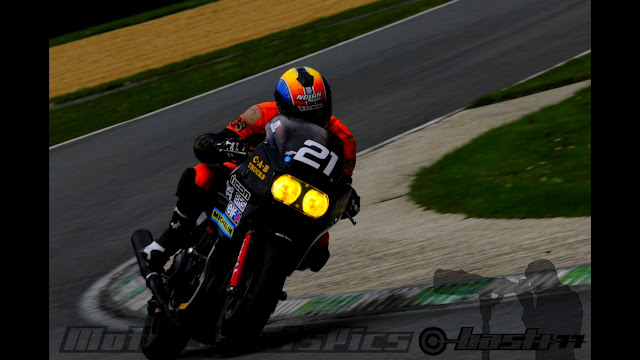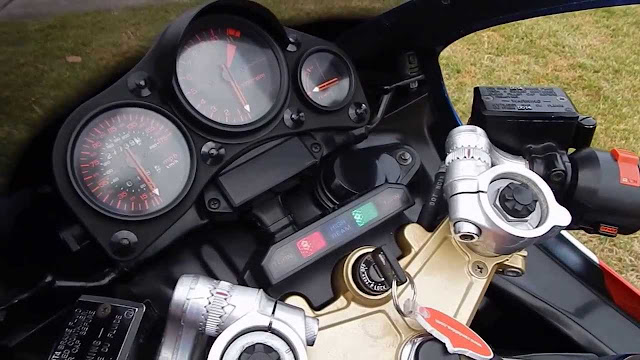The lavishly equipped, fully-faired VF1000R had a very advanced chassis specification, incorporating air-assisted front forks with anti-dive, four-piston brake calipers and adjustable monoshock rear suspension. But although it cornered well on smooth surfaces and made an excellent highspeed roadster, the Honda was too heavy and slow- steering to be a success in production racing.
Honda’s enthusiasm for the V4 engine layout in the early 1980s was such that by 1984 the VF range comprised six models with capacities ranging from 400 to lOOOcc. The fastest and most glamorous was the VF1000R: a limited-edition super-sports machine that was created, with little expense spared, to dominate production racing in the way that the straight-four CB1100R had done three years earlier.
With its full fairing and racy red. white and blue paintwork, the VF1000R looked every bit the street-legal competition machine. Its specification list was mouth-watering, based on a liquid-cooled. 90-degree V4 engine that incorporated gear-driven overhead camshafts and produced no less than 122bhp at lO.OOOrpm.
That peak power output was 6bhp up on that of the VF1000F, the standard 998cc, 16-valve V4 from which the R model was derived. The 1000F. also released in 1984, was an impressively fast and sophisticated bike. Its styling was similar to that of
The original VF750F sportster, which had promised much before suffering widely publicized engine reliability problems. The VF1000F handled well and its engine was flexible, powerful and reliable.
The exotic VF1000R cost roughly 50 per cent more than the F, and oozed quality from every pore. Its fairing was reinforced with carbon-fibre, its adjustable handlebars were made from polished alloy, its streamlined seat hump fitted perfectly. Its engine's gear-driven cams allowed more precise valve timing at high revs, which accounted for some of the extra power.
Like the other VFs, the R had a frame of square-section steel tubes, but its chassis specification was decidedly upmarket. Big 41mm front forks incorporated air assistance, adjustable damping and TRAC anti-dive. Hinged fork bottoms allowed easy front wheel removal. The Pro-Link rear shock was easily adjustable; the impressive front brakes comprised sturdy four-piston calipers and large, floating discs.
Despite the VFlOOOR's mixed reception and lack of racetrack success in its first year, only a few details including the paint scheme were changed for 1985. Although the V4 was not competitive, its stylish twin-headlamp fairing, made from plastic reinforced with carbon- fibre, gave excellent wind protection at high speed.
Few bikes have looked as deceptively racy as the streamlined VF1000R, which was far more at home on a fast road Stability and power For road riding the VF1000R was a seductively fast and comfortable companion. Its fairing combined with the racy riding position to give excellent wind protection. High-speed stability was absolute, and the engine was superbly powerful and torquey. The 1000R cruised effortlessly at well over 1 OOmph (161km/h), and surged smoothly to a top speed of 150mph (241 km/h).
The Honda’s refined feel was marred by a snatchy transmission that became annoying in town, where the engine also had a tendency to heat up its carburettors, resulting in a misfire. But such problems were forgotten when the rider found the open road, and wound back the throttle to send the 1000R storming forward with a free-flowing feel from 5()00rpm or below.
Handling was good at high speed, where the VF’s stability counted for much. But at lower speeds the Honda suffered from a weight problem. At 5241b (238kg) dry it was more than 5()lb (23kg) heavier than Kawasaki's GPz900R. and its handling was ponderous despite its 16-inch front wheel. That was a problem on the racetrack, in particular. Even Honda star Wayne Gardner just failed to take a bike that he described as a marshmallow to victor} in the prestigious Castrol Six-Hour production race n his native Australia.
Unlike its all-conquering CB11(X)R predecessor, the VF1000R was rarely seen on a circuit, let alone in the winner’s circle. That hit sales, especially as the V4’s price put it on a level with race-bred exotica from firms such as Bimota and Harris. It was fortunate for Honda that they had intended to produce only a small number. The VF1000R was fast, sophisticated and easy on the eye, but underneath that sleek bodywork it hid too much weight to be a success.
Specification Honda VF1000R (1984)
- Engine Liquid-cooled dohc 16-valve 90-degree V4
- Capacity 998cc (77 x 53.6mm)
- Maximum power 122bhp @ 10,000rpm
- Transmission Five-speed, chain final drive
- Frame Steel twin downtube
- Suspension Telescopic front; single shock rear
- Brakes Twin discs front; disc rear
- Weight 524lb (238kg)
- Top speed 150mph (241km/h)






















0 comments: